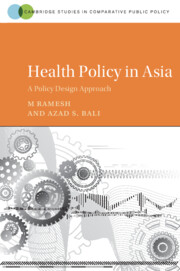Book contents
- Health Policy in Asia
- Cambridge Studies in Comparative Public Policy
- Health Policy in Asia
- Copyright page
- Contents
- Figures
- Tables
- Acknowledgements
- Abbreviations
- 1 Introduction
- 2 The Economic and Social Context of Health Care in Asia
- 3 China
- 4 India
- 5 South Korea
- 6 Thailand
- 7 Hong Kong
- 8 Singapore
- 9 Conclusion
- References
- Index
8 - Singapore
Synergizing the State and Market in Health Care
Published online by Cambridge University Press: 02 December 2021
- Health Policy in Asia
- Cambridge Studies in Comparative Public Policy
- Health Policy in Asia
- Copyright page
- Contents
- Figures
- Tables
- Acknowledgements
- Abbreviations
- 1 Introduction
- 2 The Economic and Social Context of Health Care in Asia
- 3 China
- 4 India
- 5 South Korea
- 6 Thailand
- 7 Hong Kong
- 8 Singapore
- 9 Conclusion
- References
- Index
Summary
The aim of this chapter is to explain Singapore's health care performance, and the types of policy tools deployed to achieve universal coverage. The chapter argues that Singapore has pursued the goals of affordable health care through a range of policy tools targeting specific problems that work in tandem and are fine-tuned constantly. The island state has an inordinately complex health system comprising a broad range of policy tools and it is their combined working, and not that of any one tool, that explains the system-level performance. By focussing on simply one tool, such as Medical Savings Account (Medisave), observers miss the bigger picture as well as the details of the health care system in the country. And yet, as we shall see, policy makers in Singapore are stymied by blind spots that leave crucial problems insufficiently addressed.
Keywords
- Type
- Chapter
- Information
- Health Policy in AsiaA Policy Design Approach, pp. 169 - 191Publisher: Cambridge University PressPrint publication year: 2021
- 1
- Cited by

